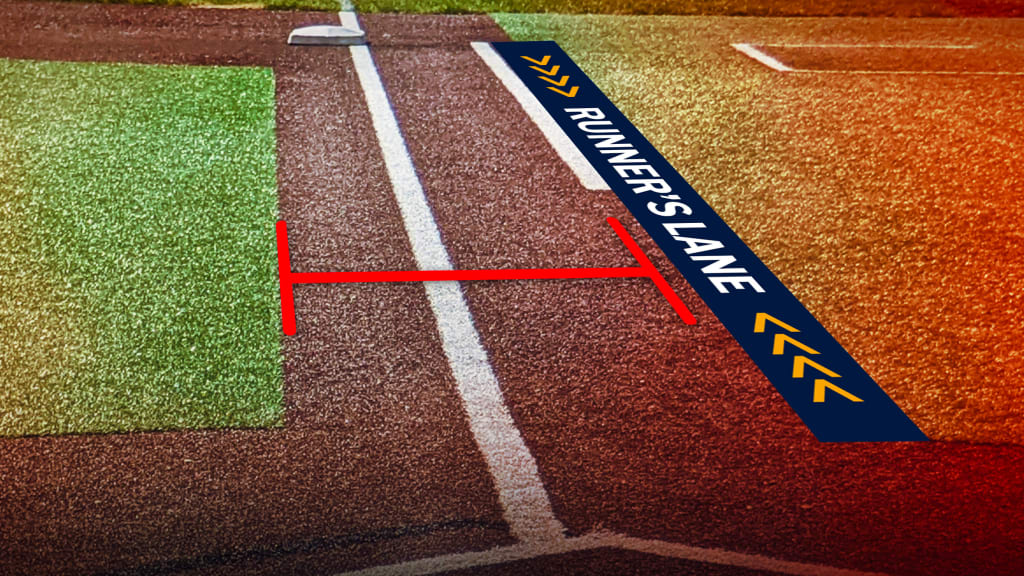
Major League Baseball is opening the express lane to first base by modifying what had been among its most confusing rules.
The joint Competition Committee voted Thursday to approve a widening of the runner’s lane to include the dirt between the foul line and the infield grass. The committee also voted to reduce the pitch clock allotment by two seconds with runners on base and reduce mound visits by one, amid other minor changes aimed at further improving pace of play. The pace of play modifications approved by the committee are aimed at getting back some of the seven minutes of average nine-inning game time that were lost by September 2023, compared to the average April game length.
A proposed rule aimed at limiting fielders’ ability to block bases other than home plate was unanimously tabled by the committee for further discussion this offseason. The players suggested addressing this issue in the Competition Committee and a rule was experimented with in the Arizona Fall League.
The runner’s lane change should be particularly well-received by right-handed batters, who now have a direct path to first base. Previously, MLB Rule 5.09 (a)(11) required a batter to run the last half of the distance between home plate and first base between the foul line and a three-foot line drawn on the right-hand side of the dirt.
Under the new rule, this runner’s lane will still be chalked in order to keep runners from drifting too far into foul territory on plays in which the ball is in foul territory, such as dropped third strikes. But instead of forcing the runner to be in foul territory (right of the foul line), the runner will now be deemed in compliance with the rule as long as both feet remain on the dirt path between home and first.
The simplicity of “dirt good, grass bad” will make for an easier evaluation by umpires.
A famous interpretation of the prior runner’s lane rule came in Game 6 of the 2019 World Series, when the Nationals’ Trea Turner was called out for interference for running to the left of the foul line on an important play. Now, the dirt area left of the foul line will be a part of the accepted lane for the runner, and the reduced distance for right-handed hitters could cause a modest improvement in batting average on infield ground balls.
A month-by-month look at average game time shows the data behind the committee’s strategy:
- April -- 2:37
- May -- 2:38
- June -- 2:39
- July -- 2:41
- August -- 2:41
- September -- 2:44
With those numbers in mind, the joint Competition Committee approved a reduction of the pitch clock from 20 seconds to 18 seconds with runners on base. The clock will remain 15 seconds with no runners aboard, and, in all scenarios, pitchers retain the ability to step off and reset the clock up to two times per plate appearance without penalty.
In 2023, pitchers began their deliveries with an average of 7.3 seconds remaining on the 20-second clock, so the reduction is not expected to have a dramatic effect on violations. When a universal 17-second clock was used for the final month of the Triple-A season in 2023, the violation rate with runners on base did not increase.
Other pace-related modifications include:
Pitching changes: If a new pitcher steps onto the warning track with less than 2 minutes remaining on the inning break clock, the clock will reset to 2 minutes, rather than 2:15. Inning breaks that contained a pitching change averaged 2:35 in 2023. Broadcasters are only guaranteed two minutes of commercial time.
Mound visits: Each team’s allotment will be reduced from five to four, though an extra mound visit will still be awarded for the ninth inning if the defensive team has zero remaining visits at the end of the eighth. In 2023, clubs averaged only 2.3 mound visits, which surveys show to be among fans’ least favorite events in baseball.
In a further effort to improve pace, umpires will permit defensive players to signal for a mound visit without actually visiting the mound. This addresses situations in which teams use a mound visit not to discuss strategy but, rather, to buy time between pitches.
Circumvention: The pitch clock operator, known as the Field Timing Coordinator, will now restart the clock after a dead ball (such as a foul ball) when the pitcher has the ball and play is ready to resume. There will no longer be a requirement for the pitcher to be on the mound, removing the pitcher’s ability to delay the start of the clock by walking around the edge of the mound.
Batter faced requirement: A pitcher sent to warm up for an inning must face at least one batter (in addition to any requirements under the three-batter minimum rule). MLB found 24 instances in 2023 of a pitcher warming up between innings and getting replaced before throwing a pitch, adding approximately three minutes of dead time per event. There were two such instances during the World Series.
The Joint Competition Committee, which was created as part of the Collective Bargaining Agreement negotiated between MLB and the MLB Players Association in 2022, is comprised of six owners, four players and one umpire. Thursday’s vote followed discussions over several offseason meetings and conversations with club general managers, managers and the executive council of the MLB Umpires Association.
“From its inception, the Joint Competition Committee's constructive conversations between players, umpires and owners have produced rules that significantly improved the game for fans,” Mariners chairman and Competition Committee chairman John Stanton said in a release. “These modifications will improve on last year's work by the Competition Committee, which was a resounding success with our fans and for the sport. I want to thank the Commissioner's Office, the Players Association and the Umpires Union for their dedication to the greatest game ever invented.”
